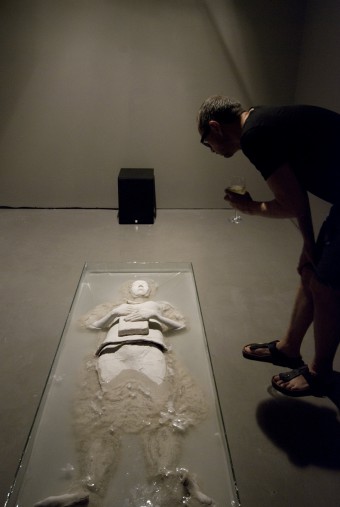
Cyrus Tang is a contemporary artist who was born in Hong Kong and now lives and works in Melbourne. Tang trained in ceramic arts at the Victorian College of the Arts, before completing her Masters of Fine Arts by research in sculpture at Monash University in 2010. Working in the fields of video and installation, her art captures a melancholy sense of dislocation from the world. She has described the process of her art making as an “eternal struggle to remember/maintain the memory of my homeland which is disappearing”.
Known for her emotive and haunting object-based practice, her sculptures often go through a process of self-destruction over time. Disappearance involved a full-sized clay sculpture of a human body that was submerged in water. The body disintegrated over several hours as the looped sound of a heartbeat filled the gallery space. Departure was a subtle installation in which water droplets fell from an air vent down onto a hot plate, disappearing in a sizzling hiss of steam. She has used a range of permanent and impermanent materials such as snow, animal bones, human hair and more recently her works have harnessed the power of fire. Through a process of dipping books, tree branches and other objects into porcelain before firing inside a kiln, she has disintegrated the objects to leave only traces of their material forms, creating a lingering sense of loss. Her work evokes personal rituals of purification through destruction, and reflects the gradual decay of all human memory.
Tang has participated in numerous exhibitions in Australia and overseas. She was the 2008 recipient of the Georges Mora Foundation Fellowship, and has undertaken artist residencies at the International Workshop of Ceramic Art in Tokoname, Japan, the Banff Centre, Canada, and Cite International des Arts in Paris, France. Tang recently completed an Asialink visual arts residency at Goyang Art Studios in Korea, and a research trip to the Echigo-Tsumari Art Field in Japan. I interviewed Tang while she was overseas to discuss her work.
Cyrus Tang is represented by Anna Pappas Gallery, Melbourne.
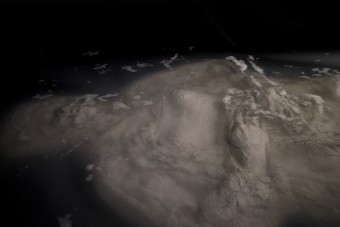
PERIL: You describe your work as a “phantasmic site of loss” through processes of nostalgia, memory and absence. Can you speak a bit about this site of loss and how it informs your work?
CYRUS: I guess when dealing with the issue of loss, what I really want is to freeze or sustain existence/presence, in a physical or psychological manner. Or maybe it’s better to say, I want to create a dialogue/linkage between the past and the present. I guess the meaning of loss implies a state of existence that moves away from itself into another state, loss or absence. This opens a space for time itself, dispersing it from its continuous present. Looking both backward and forward, the works make me think about ‘context’ in a different way.
It’s just like American artist Robert Smithson’s idea about ‘ruins in reverse’: the buildings don’t fall into ruin after they are built but rise into ruin before they are built. To me, the phantasmic site of loss suggests a particular mental orientation, a sense of lost promise combined, perhaps, with a desire to redeem that promise in the future. It is a contemplative mode of thought that might lead to nostalgia or resign to the past to test against the present.

PERIL: Your art often employs a range of permanent and ephemeral materials including clay, water, ash, steam, snow, human heartbeats, animal bones and human hair. The gradual disintegration of your chosen materials reflects a process of disappearance that is central to your art practice. Can you discuss this?
CYRUS: There is an interesting relationship between permanence and the ephemeral. To me the representable is inseparable from the non-representable. It’s something to do with “time”: an element that may survive at the point of invisibility. Poetically, something happens in the object allowing the past and present to converge.
For me, the process of disintegration/destruction is the convergence of the past and present. The process of disappearance of the physical objects creates a permanent image in our memory.
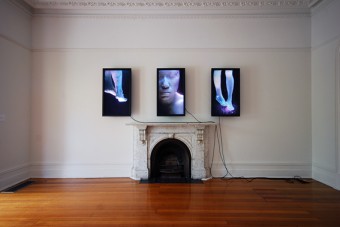
PERIL: In works such as Body Ruins and Remote Nation, water is used as a medium through which bodies and cities made of clay dissolve into nothingness. In Branches and Frozen Moment twigs and books are coated in porcelain and then fired in a kiln, destroying the organic material to leave only the shell. Can you discuss the use of elemental forces such as fire and water in your work?
CYRUS: I guess there are multiple meanings about fire. People with traumatic experiences try to forget their memories by burning things like photos and letters that trigger them to have a flashback. Yet, burning objects cannot burn human memory. Our memory and history cannot be killed by fired. In the Chinese tradition, people like to burn objects as offerings to their ancestors. They believe that their ancestors from other worlds would receive the offerings through the firing process.
The projects Branches and Frozen Moment attempt to capture the void/negative space. The kiln firing aims to strengthen/emphasise the existence of these voids. Besides, the firing is the transformation of the clay from one form to another permanent form.
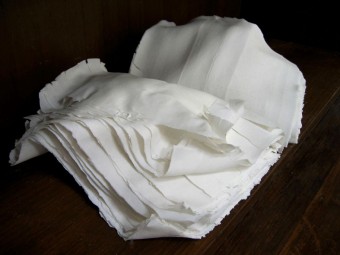
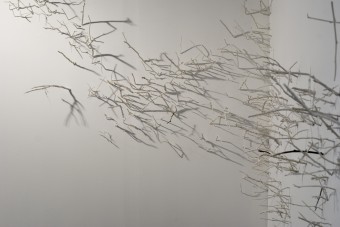
I like to use water because of the fluidity. The different states of snow, ice, water and steam fascinated me a lot. It is ephemeral and permanent at the same time. When water transforms to steam, we are not able to see it anymore but it exists in the air. The water element in Body Ruins and Remote Nation is used to visually disintegrate the city/body. But actually, water transforms the city/body into another state of existence. I always find the residue (after the clay totally melts into water) moves me a lot.
PERIL: Momentary Gleam was a powerful installation, which consisted of a single length of human hair – your own and that of your family – measuring 89 metres, on which you grew salt crystals and suspended as a shimmering line that cascaded down into the darkened space and onto the gallery floor. Can you talk a bit about this work?
CYRUS: Hair suggests fragility and the ephemeral yet remains long after the body’s death. It carries an ambiguous materiality: a series of dead, keratinized cells, hair grows from beneath the scalp’s surface, which teems with blood vessels and bacterial life. Its inert biology is always animated as it splits and sheds. At once in and of the skin, extending and striating the body by drawing the subject beyond the dermis while rooting her within it, hair is the flesh’s last claim to life as it is eclipsed by death and decay. The idea of growing crystals from human hair is a strategy to freeze the residue of memory, like embalming a dead body. Preserving bodies after death is a process that has evolved considerably over the centuries. To grow crystals around a thread of human hair more or less is a way to preserve the residue of everyday life.
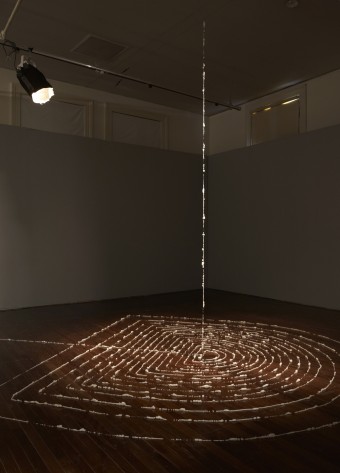
The idea of asking my family in Hong Kong to save their shed hair for me is a gesture to create a link between me and my family. My family has no background about art and they don’t really understand what I am doing and why I am doing it. I remember when I asked them to donate the sound of their heartbeats to me. They just did it as a gesture to give me support. They didn’t ask me why or what is it about. And the same with the hair. However, the hair work meant a lot to me. I guess, for them the heartbeat recording was a simple action, it didn’t cause a lot of trouble or effort. While collecting the shed hair everyday, bit by bit, it was an effort for them. They did it for me. When I received the mail from my mum who saved all her hair in medicine bags (because my mother has multiple health issues), and from my brothers who put their hair in red pockets (because it was Chinese New Year), it was very touching.
I did think of a lot of options about how to set up the hair crystal work, like making a spider web in the gallery space, to make the viewer feel like they were being trapped in my family web. However, finally I decided to make it very simple because I wanted to emphasise the beauty of the material. The pattern on the floor is inspired by the ‘crop circle’. It is semi circle, a circle which is incomplete because after this project, it didn’t mean that I connected with my family. We still have that distance, no matter physically or psychologically.
PERIL:What are you working on in the future?
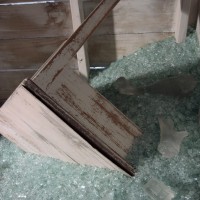

CYRUS: I do believe my experiences impact upon a lot of my practice. Those experiences include my work as a social worker and my personal experience of my father passing away.
One day, I realised that I never hug my family (because it is awkward in Chinese culture, and in particular for my family culture). I want to make an installation that presents the suspended moment of hugging between me and each of my family members.
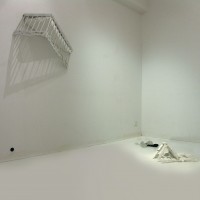
At the moment, I am working on a project related to unidentified bodies. When I collect human hair from the salon, they pass ponytails of hair from unknown people to me. I started to think about people who have passed away without notice, it is like hair from unknown people. There is a strange relationship between the two. I want to continue to develop on that. That will be a series of photographs of photo projections on human hair. I guess these photos are ghosts already, when they are projected through a video projector, their existence is more strange. I don’t know how to describe it. When I took the pictures of the projections onto unknown human hair, it is very strange. I feel these people are between existence or non-existence. People exist because they have stories, but these people no longer have any stories.

